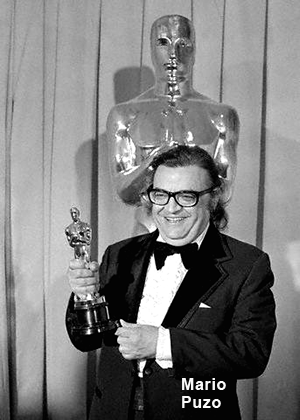
BIOGRAPHY
REMEMBERING MARIO
M. J. Moore

When he got out of the taxi, he collapsed curbside. It was Christmas Eve in 1955.
By now the cold air was just frigid enough to make his face sting whenever the wind blew. And New York City, of course, with most of its routine hurly-burly drastically diminished by the grand pause that only certain major holidays can induce, had that unmistakable overlay of forlorn Yuletide stillness. December 24th was hardly the ideal night for a gall-bladder crisis.
Somehow, though, it was an apt night for the kind of private, thoughtful mental reckoning that a bout of illness often produces. The man who fell by the curb that night was neither old nor feeble. He had no chronic medical problems. In general, like most other men of his generation, this 35-year-old man (who crumpled as soon as he hauled himself out of the taxi) was assumed to be in the prime of his life.
In the magazine-saturated and advertising-centric TV culture of 1955, it was the men of this demographic—the guys of the G.I. Bill generation, supposedly rising in the world ten years after the war ended; the ex-soldiers and former sailors, airmen and marines—who, ostensibly, had the world by the tail.
They were newly minted executives, in many cases. Or ambitious lawyers. Untold numbers were striving salesmen. Some were future judges. Freshly appointed assistant professors were in their ranks; and in all other job and career fields (from factory work to scientific research) the thirty-something panorama represented the largest aggregate of the postwar generation of male Americans, many millions of them, who served in the military during World War Two (1939-45).
Now, on Christmas Eve in 1955, this 35-year-old ex-G.I. (who’d spent four years in uniform--some of it with the Fourth U.S. Armored Division--in the Second World War and who was now married with four children) looked skyward from the curb out in front of the VA hospital, at which he’d arrived alone.
For him, 1955 was clearly ending with symbolic distress. Earlier that year—back in February of ’55, this man’s first novel was published by Random House. A more powerful publisher did not exist. And the novel, over which he had labored for several years, was reviewed in high-profile venues.
Positive critics had hailed the new author, comparing his debut work to the first novels of Norman Mailer (The Naked and the Dead was his 1948 best-seller) and James Jones (his From Here to Eternity remained a perennial best-seller after its blockbuster 1951 publication). Negative critics had argued that the new writer was even “dirtier” than either Mailer or Jones, both of whom received much criticism for the profanity-laced chapters that formed their respective novels. Nonetheless, both Mailer and Jones (though critics were divided on their works) enjoyed hefty sales.
The vagaries of the book business being what they were, no such luck shone upon the man who could now scarcely rise from the ground. In his case, despite several glowing reviews and a big push from the Random House publicity machine, the sales for his novel The Dark Arena were not just slight. They were meager.
In addition to his book sales being minimal, Hollywood showed no interest in buying the film rights to The Dark Arena, a somber novel about moral ambiguities in the postwar U.S. Army in occupied Germany.
Well, so much for any hope of quitting his low-paid, civil service administrative job.
More than twenty years later, the man who fell out of the cab that night would recall that it was then—just then—that he had an epiphany: “It was Christmas Eve and I had a severe gall-bladder attack. I had to take a cab to the Veterans Administration Hospital on 23rd Street, got out and fell into the gutter. There I was lying there thinking, here I am, a published writer, and I am dying like a dog. That’s when I decided I would be rich and famous.”
By the time novelist Mario Puzo offered that quotation to TIME Magazine for its 1978 cover story entitled “The Paperback Godfather,” things had changed. Not overnight. Not quickly. After 1955, it took another decade and a half of struggle, persistence, solitary writing and visionary intuition . . . but when The Godfather (Puzo’s third novel) was published in March 1969, a phenomenon emerged.
It was such a phenomenon that when Mario Puzo reflected in 1978 on what it was like to find himself “dying like a dog” at 23rd Street on Christmas Eve back in 1955, he did so knowing that there were more copies in print of The Godfather than any other book on the planet, except the Bible.
He did so knowing that because of his third novel’s international success, and with two extraordinary films from 1972 and 1974 (both directed and co-written by Francis Ford Coppola) forever reinforcing interest in the book, there were now trust funds for all of his children.
Perhaps most poignant of all was that Puzo ruminated about Christmas Eve ’55—surely one of the low points in his twenty-year struggle to achieve success as a writer—while knowing full well that his wife, Erika, was dying of breast cancer.
Only three months after the August ’78 TIME magazine cover story appeared, Erika Puzo died. It was a somber Thanksgiving. They had been married more than 30 years. They raised five children. They met under unusual circumstances at the end of World War Two (Erika was a German citizen; Puzo was the G.I. she fell in love with) as the U.S. Army shifted its focus from combat to occupation.
If anyone had hinted to the uniformed Puzo and his war bride that they and their children would one day appear in a LIFE magazine photo-essay, loud guffaws would have erupted.
(M. J. Moore is writing a biography of novelist James Jones.)